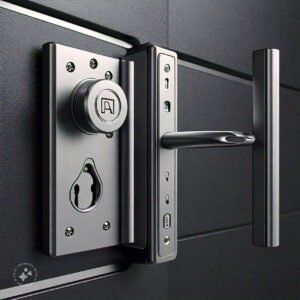Introduction to the Importance of Door Locks in Home Security:

Door locks stand as the first line of defense against potential threats in the realm of home security. They serve as the physical barrier that shields our homes, possessions, and loved ones from unauthorized entry. Beyond their utilitarian purpose, door lock also contribute to our peace of mind, allowing us to feel safe and secure within our own spaces. The importance of door locks lies in their ability to deter burglars and intruders, thereby reducing the risk of break-ins.
Historical overview of door locks development:

Step . 1
Throughout history, door lock development has evolved from simple wooden latches to intricate, high-tech security systems. In ancient civilizations, like Egypt and Mesopotamia, locks were crafted from wood and rope.
Step . 2
The Middle Ages introduced more advanced mechanisms, like the warded lock. Fast forward to the 18th century, and the tumbler lock became popular. Linus Yale Sr.’s invention in the mid-19th century revolutionized lock with his pin tumbler design.
Step . 3
Today, digital lock, biometrics, and smart technology define door security. From ancient simplicity to modern complexity, door lock development mirrors our need for safety, reflecting innovation and adaptability throughout the ages.
Types of door locks: traditional vs. modern:
Certainly! Door lock have evolved over time, with traditional and modern types offering distinct features.
Traditional Key Locks:
These locks use physical keys to secure doors. They are simple, reliable, and affordable.
Deadbolt Locks:
A subtype of traditional locks, deadbolts are sturdier, making them more secure. They require a key to operate and are commonly used in conjunction with regular locks.
Modern Electronic Locks:
These locks use keypads, fingerprint recognition, or smart apps for access. They offer convenience, allowing remote access and temporary codes for guests.
Smart Locks:
Advanced electronic locks connect to your home automation system. They offer features like voice control, activity logs, and integration with other smart devices for enhanced security.
Biometric Locks:

Cutting-edge technology uses fingerprints, retina scans, or facial recognition for access. Biometric locks provide the highest level of security but can be expensive.
Choosing between traditional and modern locks depends on your security needs, budget, and preference for convenience.
Exploring smart door lock technology and its features:
Understanding Smart Door Lock Technology:
Smart door lock technology represents a revolutionary leap in home security. These advanced locks employ cutting-edge mechanisms, often incorporating biometrics or smartphone connectivity. Gone are the days of traditional keys, as these locks offer convenient, keyless access to your home.
Features That Set Smart Door Locks Apart:
These locks come packed with impressive features. Most allow remote control, enabling you to lock or unlock your door from anywhere via a mobile app. Biometric recognition, like fingerprint or facial recognition, enhances security. Some models even offer temporary access codes for guests. Smart door locks are designed to seamlessly integrate with your home’s automation system, adding an extra layer of convenience.
The Future of Home Security:
Smart door lock technology is continuously evolving, with new features and integrations on the horizon. As they become more widespread, they promise not only convenience but also increased security and peace of mind for homeowners. This innovative technology is reshaping the way we think about home security, making our lives easier and safer.
Step-by-step guide to installing a door lock:
Door Lock Installation Guide
Certainly! Installing a door lock is a valuable skill that enhances your home’s security.
a . Gather Your Tools:
Start by gathering essential tools like a screwdriver tape measure, pencil, and the new lockset.
b . Remove Old Hardware:
Unscrew and remove the existing lock and knob, ensuring the door is open.
c . Measure and Mark:
Measure the door’s thickness and mark the center for accurate placement.
d . Install the Latch:
Attach the latch assembly, aligning it with the marked center and securing it with screws.
e . Add the Strike Plate:
Position the strike plate on the door jamb and screw it in place.
f . Install the Lockset:
Insert the lockset into the door hole, securing it with screws.
g . Attach the Knobs or Handles:
Slide the interior and exterior knobs/handles onto the spindle and secure them.
h . Test the Lock:
Close the door and test the lock for smooth operation.
i . Final Adjustments:
Make any necessary adjustments to ensure the lock functions correctly.
j . Finishing Touch:
Tighten all screws, and your new door lock is ready to enhance your home’s security.p
Remember, take your time and follow these steps carefully to ensure a secure and functional door lock installation.
Maintenance tips to ensure the longevity of your locks:
a . Regular Cleaning:
Maintaining the longevity of your locks begins with regular cleaning. Dust, dirt, and grime can accumulate over time, leading to lock malfunctions. Use a soft brush or compressed air to remove debris from keyholes and mechanisms. Follow up with a gentle application of lubricant to keep everything moving smoothly.
b. Lubrication
This involves proper lubrication. Apply a silicone-based lubricant sparingly to your lock’s keyway and moving parts. This reduces friction and wear, ensuring your locks remain functional for years. Avoid using oil-based lubricants, as they can attract more dirt.
c . Periodic Inspections:
Lastly, conduct periodic inspections. Check for loose screws, misalignments, or signs of wear. Address any issues promptly to prevent more extensive problems. Regular maintenance ensures your locks remain reliable and secure, offering peace of mind for years to come.
A look at the aesthetics of door lock design:

Lock Aesthetics Style Matters.
a . Aesthetic Appeal:
When we consider door lock design, aesthetics might not be the first thing that comes to mind, but it plays a crucial role. The style of a lock can subtly enhance the overall look of your door.
b . Form and Function:
A well-designed lock marries form and function seamlessly. Sleek, modern locks complement contemporary homes, while ornate designs can add a touch of elegance to traditional architecture.
c . Material Matters:
The choice of materials is pivotal. High-quality metals like brass or stainless steel not only ensure durability but also contribute to the visual appeal. They can gleam in the sunlight or develop a charming patina over time.
d . Blend or Contrast:
Door locks can either blend in with the door’s design or stand out as a striking focal point. Choosing whether to blend or contrast depends on your personal taste and the overall aesthetic of your space.
e . Personal Expression:
Ultimately, door lock design is an opportunity for personal expression. It’s a chance to make a subtle statement about your style and attention to detail, proving that even the smallest elements can have a big impact on the overall ambiance of your home.
7 . How biometric door locks function and their security benefits?
Biometric door locks revolutionize security by utilizing your unique biological features, here are some points.
Step . 1
When you approach, the lock scans your fingerprint, retina, or facial features, converting them into a digital code.
Step . 2
If the code matches the stored data, access is granted. This high-tech approach eliminates the need for traditional keys, thwarting lock-picking and unauthorized entries. Biometric locks offer enhanced security, as only authorized individuals can gain entry, ensuring your peace of mind and safeguarding your home or office.
8 . Dealing with lockouts: tips and tricks:
a . Stay Calm and Assess:
Lockouts can be incredibly frustrating, but the first step is to stay calm. Inhal deeply and understand the situation. Check if there’s a spare key with a neighbor or friend, or if you have a spare hidden somewhere safe. Sometimes, a simple solution is closer than you think.
b . DIY Techniques:
If no spare key is available, try some DIY techniques. For doors, a credit card or a paperclip can sometimes do the trick. For digital locks, ensure you remember your code. But be cautious, as forcing entry can cause damage or even legal issues.
c . Call a Professional:
When all else fails, it’s time to call a locksmith. They have the skills and tools to safely unlock doors without causing damage. It may cost a bit, but it’s worth it for your peace of mind and security.
Remember, lockouts happen to everyone, and with these tips and tricks, you’ll be better prepared to handle them calmly and efficiently.
9 . Childproofing your home :
Childproofing with Door Lock.
Step . 1
Safeguarding your little one’s curiosity is a top priority. Start childproofing your home by installing child-safe door locks. These nifty devices keep doors securely shut, preventing adventurous explorers from entering danger zones.
Step . 2
Child-safe door locks are a breeze to install and use. They offer peace of mind without compromising your daily routines. With various styles available, you can choose one that seamlessly blends with your decoration.
Step . 3
Embrace a safer, worry-free home. Childproofing with door locks ensures your child’s well-being, allowing them to explore and play in secure spaces while giving you confidence and freedom in your daily life.
10 . Evaluating the vulnerabilities of traditional locks:
Step . 1
Traditional locks may seem secure, but they have hidden vulnerabilities.
Step . 2
These vulnerabilities include lock-picking, bumping, and even impressioning, which can compromise their effectiveness.
Step . 3
To enhance security, consider modern alternatives like smart locks with advanced encryption, making it harder for intruders to exploit these traditional weaknesses.
11 . Creating a home security checklist centered around door lock:
Step 1 . Assess Your Locks:
Begin by evaluating your existing door lock. Check for any signs of wear, rust, or malfunction.
Step . 2 . Choose High-Quality :
Select robust, pick-resistant lock. Look for deadbolt lock with a one-inch throw, which provides enhanced security.
Step. 3 . Reinforce Door Frames:
Strengthen the door frames with strike plates and longer screws to prevent forced entry attempts.
Step. 4 . Install Peepholes and Chain Locks:
Enhance visibility and control with peepholes and chain lock, allowing you to verify visitors before fully opening the door.
Step. 5 . Develop Locking Habits:
Educate your family on locking habits and ensure everyone consistently locks all doors when leaving or at night. Regularly review and update your checklist to maintain a secure home environment.
12 . Common door lock issues and DIY solutions:
a . Stiff Locks:
If your door lock feels stiff or difficult to turn, it’s likely due to dirt or debris inside. Try spraying a lubricant like WD-40 into the keyhole and around the latch mechanism. Work the key in and out to distribute the lubricant evenly.
b . Loose Door Handles:
A wobbly door handle can be frustrating. Tighten the screws on the handle with a screwdriver to secure it. If the screws are stripped or won’t hold, consider replacing them with slightly longer ones for a more secure fit.
c . Key Stuck in Lock:
When your key gets stuck, don’t force it. Instead, try graphite powder, a pencil lead, or a silicone-based lubricant to ease the key out. If that doesn’t work, call a locksmith.
d . Misaligned Latch:
If your door won’t close properly, the latch may be misaligned. Loosen the strike plate screws, adjust the plate’s position, and tighten them again.
e . Deadbolt Doesn’t Extend:
When a deadbolt won’t extend fully, check the strike plate alignment and make sure the bolt isn’t obstructed. Lubricate the bolt and mechanism for smoother operation. If it persists, you might need a locksmith’s help to diagnose the issue.
13 . The future of door lock technology and home security:
a . Advancements in Biometrics:
The future of door lock technology and home security promises to be revolutionary. Firstly, we can expect an increased reliance on biometrics. Imagine walking up to your door, and it recognizes your unique fingerprint, retina, or even your facial features. This level of personalization not only enhances security but also simplifies access control.
b . Integration with Smart Home Systems:
Step into the future, where door locks seamlessly integrate with your smart home ecosystem. These locks will communicate with your smartphone and other smart devices, allowing for remote monitoring and control. Forgot to lock the door? No problem, just tap your phone.
c . AI-Powered Threat Detection:
Artificial intelligence will play a pivotal role. Advanced AI algorithms will analyze patterns, detect anomalies, and thwart potential threats. Imagine your door lock learning your daily routine and alerting you if something seems off, providing an extra layer of security.
d . Sustainable and Eco-Friendly Solutions:
Lastly, the future of door lock technology will prioritize sustainability. Eco-friendly materials and energy-efficient designs will become the norm, ensuring that home security is not at odds with environmental responsibility.
In summary, the future of door lock technology and home security promises a blend of personalization, connectivity, intelligence, and sustainability, ensuring that your home remains your fortress in an ever-changing world.
